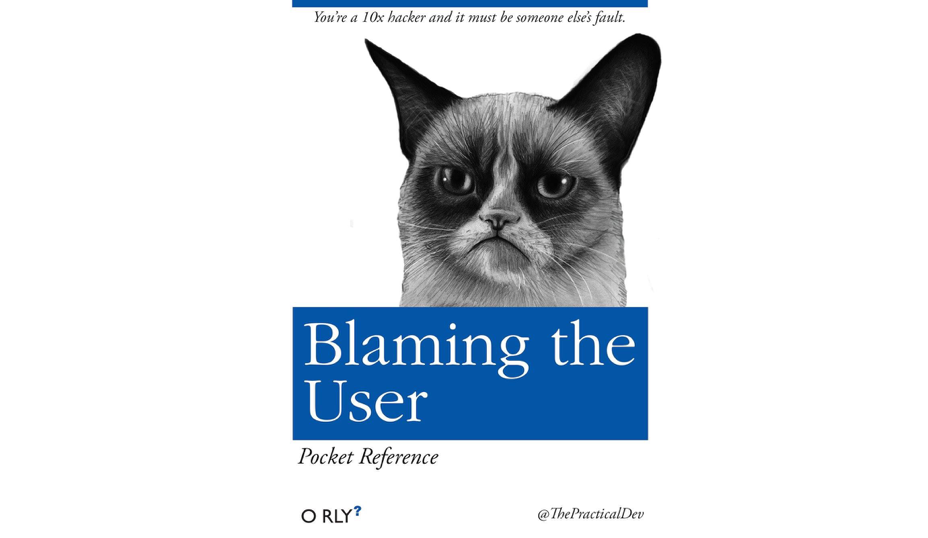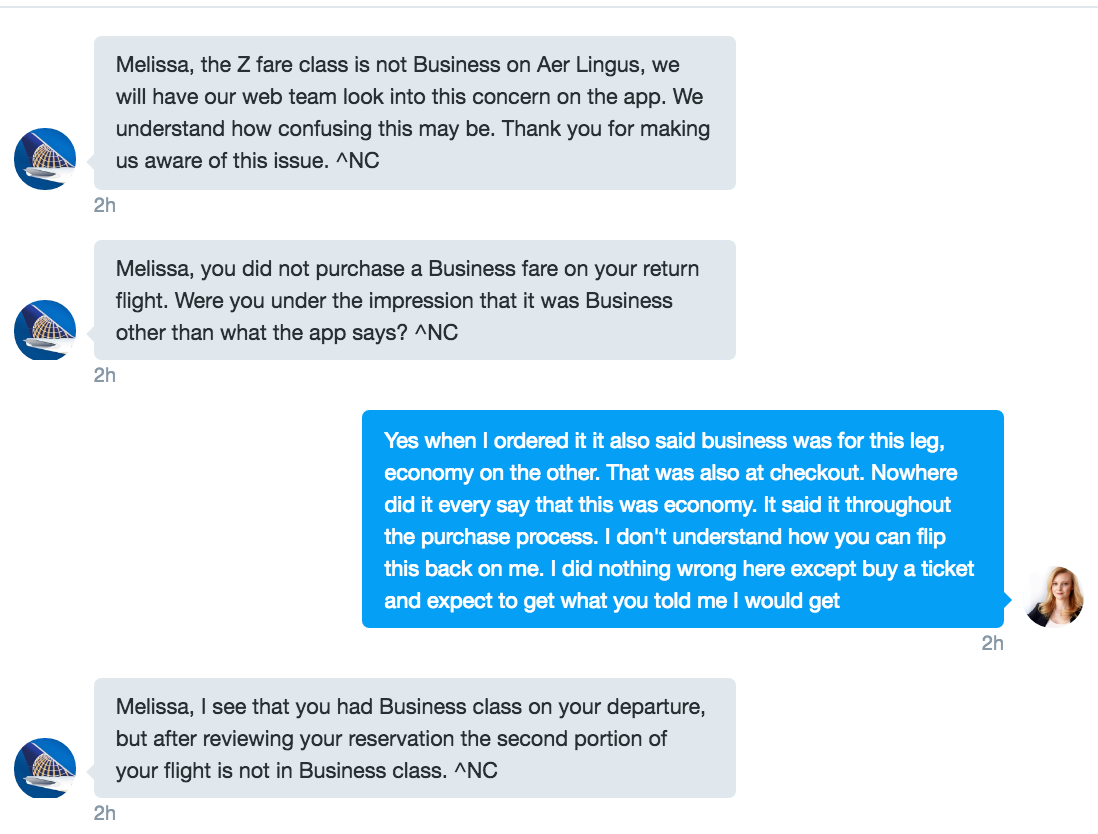Stop Blaming the User

I’m finally going home from a long business trip and I’m very excited. But my experience with United Airline’s customer service this morning completely killed my good mood.
They keep blaming me for their mistake. It’s a story I know well because I see it so commonly in Product Management too.
When I was booking my return ticket from London to Newark, the cheapest option was for something called “Mixed Cabin”. I could fly Business Class between London to Dublin and then Economy from Dublin to Newark. Since I had to get up at the ungodly hour of 5am to get to the airport, I thought that could be a nice treat on my first leg. So I booked it.
Here’s what my reservation looks like from a few minutes ago:

Imagine how surprised I was when I checked in for the first leg on Aer Lingus and they gave me seat 27B. “There must be a mistake,”,I thought. So I told the flight attendant that I was booked through United in Business. She replied, “We don’t have Business Class on any of our flights.”
What a bait and switch! United is selling me something that doesn’t exist. It’s only a one-hour flight, so I’m not going to hem and haw all day, but I wanted to get to the bottom of it. So, I tweeted… because that’s what you do when you’re angry. What happened next, pissed me off more than the switcheroo.
The customer service agents considered this my fault, and acted like it wasn’t a big deal.

As someone who doesn’t work for an airline, how am I supposed to know that Z class doesn’t exist on Aer Lingus? When you purchase your ticket and it says “Business”, that’s what you expect. I don’t think I am wrong for being upset; yet United is telling me I am. If I went to a restaurant and ordered the duck, the waiter wouldn’t say “I’m sorry, we actually meant steak when we wrote duck. Here’s your steak, deal with it.”
I’m not telling this story to complain about United (well, maybe that’s part of the reason). The moral of my story is this: I see product teams commiting this classic mistake all the time. Product Managers love to blame the user. If the user doesn’t understand something, they are just stupid. If the user won’t tell us what they want, they are difficult. If they are calling to complain, they are ungrateful.
This is a dangerous mindset, yet it’s so prevalent. “Users don’t know what they want,” is the battle cry of Product Managers all over the world. It’s their excuse not to talk to them, because what could a user tell them that they don’t already know?
The problem isn’t with the user. It’s with you.
The Curse of Knowledge Bias makes you forget that as a Product Manager, you have more knowledge than the user when it comes to your product. You can’t understand how they could find something difficult when you can do it so easily. Users become just a thorn in your side, and if they went away and took all their complaints and wishy-washy answers to your questions with them, you could build THE BEST PRODUCT IN THE WORLD! You forget that if users went away, you would be out of business.
Recently, I was training Product Managers at a very large company. I always start off with a major focus on the user and trying to uncover their problems. We did a Product Kata workshop to help demonstrate this. The idea behind Product Kata is to take a step back, figure out what you need to learn, and create a test or step to learn it. In this case, the teams had to create a “paper pizza” for the user. Chris Matts helped out by being our user. They had 45 minutes to sell Chris $10 worth of pizza. Everyone immediately jumped in and started asking him “What do you want?” He answered, “I don’t know what I want. I like these things…”
After a while, everyone hated Chris. Someone even said, “I am going to pivot my pizza business to martial arts because Chris better learn to defend himself.” That was pretty funny, but also a prime example of the problem. This happens all the time in real life. The reason people were getting frustrated is because they were asking Chris, “What do you want?”
It is not the user’s job to know what they want.
It‘s their job to know what problems they have. You need to understand how to question them about their context, problems, and needs. If you cannot do this well, you will end up getting frustrated with the user. When I interrupted the teams from running around like chickens with their heads cut off, I asked them “What do you need to learn?” No one had even thought of that question (even though I just taught them they should!). They just set to work to immediately build a bunch of crap hoping he would buy it.
When they stopped and realized they needed to learn the context in which he was eating the pizza, they were able to solve it within 5 minutes. After 30 minutes of wasting a bunch of paper pizzas.
Sound familiar?
It is easy to blame the user, but it is so dangerous for organizations. It leads to culture of disdain for our customers and whole lot of arrogance on our part.
In large companies this is particularly true. When you have layers of bureaucracy, very long-term employees, and a million different departments separating you from the user, it’s easy to forget about them. Product Managers in these companies say, “We can’t talk to the user, that’s the job of another department.”
There are always ways to learn more about your customers, even if you have different departments. For example:
- Go talk to the customer service team. When I was working with a client at the beginning of the year, we had trouble finding users to talk to. We could easily talk to people who already signed up, but we couldn’t get in touch with people who dropped off. Customer service could, though. We talked to them about what we were trying to learn, and gave them questions to ask. Then, we met with them weekly to go over what they learned from the users. This helped a lot. If you can, even go so far as to take customer service calls a few times a month.
- We designed ways to learn more from our user in the above case, as well. We implemented things like Qualaroo to get feedback from users when they were dropping off. They were allowed to type whatever they wanted in a box asking, “What’s stopping you from signing up today?” We got thousands of responses and learned the biggest problems.
- When I was working for a B2B company, I was told I wasn’t allowed to talk to users because we would disturb them. I was the head of UX there. I fought for that ability, and was allowed to go with a sales team member. In that interview, I was able to prove that what we were building was not what the user expected. I brought that back to the team, and it gave me more buy in to keep doing more interviews. We ended up setting up a little feedback group of some willing customers and gave them access to tools earlier than others, and some extra hands on support. This proved invaluable for our discovery methods.
It’s easy to forget that the reason our businesses exist is because someone is buying our product. Someone. Not a nameless persona full of stats, but actual human beings. Human beings have feelings and needs. When I am paying United for a service and they are telling me, effectively, that I’m wrong, I feel frustrated. I feel wronged. That leads me to start to look for their competitors. I’ve bet you felt that too on just about any airline. How many times have you tweeted that they don’t care about you? Felt that they don’t care about their customers in general?
It’s the same for your users. How do they feel when you do this? Blaming them is not the answer. I never said it was easy to talk to users, but it is the only way you can understand and build empathy for them. This is what makes a good Product Manager. If you don’t want to talk to users, get another job. If you’re willing to give it a shot, remember to take a step back and put yourself in their shoes.